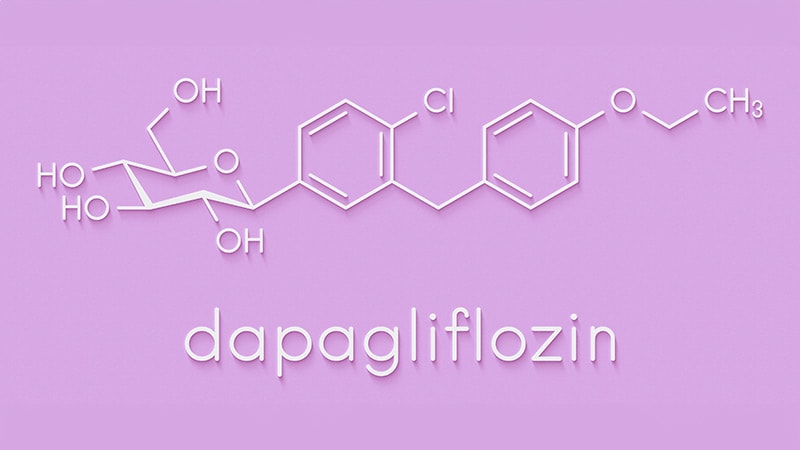[ad_1]
CHICAGO — For older patients at high risk for a heart failure event who are scheduled for transcatheter aortic valve implantation (TAVI), dapagliflozin, a sodium glucose cotransporter 2 (SGLT2) inhibitor, reduces the risk for death and heart failure events by almost 30%, the randomized DapaTAVI trial shows.
The two questions addressed in this “pragmatic” trial — whether adjunctive SGLT2 inhibitors are beneficial after TAVI and whether SGLT2 inhibitors are safe in older patients — were answered affirmatively, according to Sergio Raposeiras-Roubin, MD, PhD, professor of cardiology at Universidade de Santiago de Compostela in Spain.
The mean age of the trial participants was 82 years, which is not atypical for TAVI studies, but diverges markedly from the landmark trials that established SGLT2 inhibitors as a guideline-directed medical therapy in heart failure.
Patients were randomized at 39 centers in Spain, said Raposeiras-Roubin, who presented the DapaTAVI results during a late-breaker session at the American College of Cardiology (ACC) Scientific Session 2025, which were published simultaneously in The New England Journal of Medicine.
Trial Enrolled Patients With Preexisting Heart Failure
TAVI patients were enrolled in DapaTAVI, if they had severe aortic stenosis and a previous heart failure episode that led to treatment with an intravenous diuretic in a hospital or an urgent care facility. In addition, patients were required to have one or more of the following risk factors: Diabetes, compromised renal function (an estimated glomerular filtration rate of 25-75 mL/min/1.73 m2), or a left ventricular ejection fraction of < 40%.
The primary endpoint was a composite of all-cause death and worsening heart failure.
At 1 year, 91 patients (15.0%) randomized to dapagliflozin 10 mg once daily experienced a primary outcome event, as did 124 patients (20.1%) randomized to usual care. SGLT2 inhibitors were associated with a significant 28% risk reduction (hazard ratio [HR], 0.72; P = .018).
When composite primary endpoint events were assessed separately, the rate of death at 1 year in the dapagliflozin group was lower than in the usual care group (7.8% vs 9.1%) but did not reach statistical significance (HR, 0.87; 95% CI, 0. 59-1.28). However, the lower rate of worsening heart failure in the dapagliflozin group (9.4% vs 14.4%) was significant (HR, 0.63; 95% CI, 0.45-0.88).
There were also significant reductions in hospitalization for heart failure (HR, 0.68; 95% CI, 0.46-0.99), urgent heart failure visits (HR, 0.46; 95% CI, 0.26-0.82), and cardiovascular death or hospitalization for heart failure (HR, 0.71; 95% CI, 0.51-0.98). The numerical reduction in cardiovascular death was not significant (HR, 0.81; 95% CI, 0.49-1.35).
In subgroup analyses, the relative advantage of being randomized to dapagliflozin rather than usual care was similar for those with and without diabetes, with and without renal insufficiency, and with and without compromised left ventricular function.
Although dapagliflozin was generally well tolerated in this trial and in past trials, it was associated with more symptomatic hypotension events per 100 patient-years (6.6 vs 3.6; P = .01) and more genital infections (1.8 vs 0.5; P = .03). None of these adverse events resulted in meaningful sequelae, though.
SGLT2 Inhibitors Not Routinely Offered to TAVI Patients
Given the role of SGLT2 inhibitors has already been established as a pillar of guideline-directed medical therapy in heart failure, the benefit in TAVI patients with a history of heart failure should not be entirely surprising, said Ori Ben-Yehuda, MD, director of the Cardiovascular Outcomes Group at the Sulpizio Cardiovascular Institute, University of California San Diego, and the author of an editorial that accompanied the DapaTAVI results.
Because of their history of heart failure, SGLT2 inhibitors were already indicated for patients in the DapaTAVI trial, Ben-Yehuda noted.
However, the “pervasive assumption” that TAVI solves the problem of heart failure related to aortic stenosis might explain why SGLT2 inhibitors are not commonly considered after TAVI. But SGLT2 inhibitors were associated with risk reduction in DapaTAVI, despite successful valve replacement. The separation in the event curves in favor of dapagliflozin was evident in the 30 days after randomization and is, in the opinion of Ben-Yehuda, immediately relevant to clinical practice.
“The positive outcome data of this trial are important and should influence the treatment of patients after TAVI,” Ben-Yehuda said.
“I know for me it will be practice changing when I go back to New York next week,” said Deepak L. Bhatt, MD, director of the Mount Sinai Fuster Heart Hospital in New York City, who was the ACC-invited discussant. “I think I am pretty good about making sure my patients with heart failure and without contraindications are on SGLT2 inhibitors at discharge, but I must say that in my TAVI patients, SGLT2 inhibitors have not been part of the checklist.”
He said he now plans to offer an SGLT2 inhibitor to all TAVI patients with heart failure who do not have a contraindication to this therapy. Importantly, this includes older patients.
The older population has “largely been excluded from SGLT2 inhibitors in most cardiovascular outcome trials,” said Bhatt, who estimated that patients aged 70 years or older make up < 10% of those randomized in pivotal SGLT2 inhibitor outcome trials.
“Despite TAVI, patients with aortic stenosis still face high rates of heart failure events,” Raposeiras-Roubin observed. The routine initiation of SGLT2 inhibitors could address this problem.
Raposeiras Roubin and Ben-Yehuda reported no conflicts of interest. Bhatt reported having financial relationships with more than 45 pharmaceutical companies, including Bristol Myers Squibb, which manufactures dapagliflozin.
[ad_2]
Source link : https://www.medscape.com/viewarticle/sglt2-inhibitors-progressing-new-standard-after-tavi-2025a100081y?src=rss
Author :
Publish date : 2025-04-03 13:34:00
Copyright for syndicated content belongs to the linked Source.
